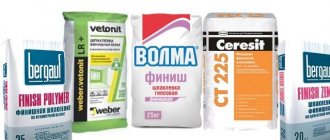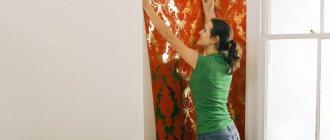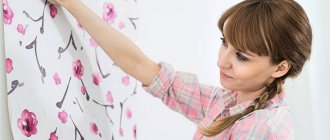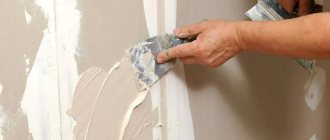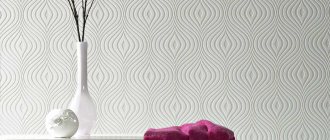Features of application
Fiberglass is used to secure finishing putty or other finishes. This thin and lightweight material can be used at any angle and on any surface. In addition, it improves the surface structure and ensures its wear resistance.
How and why to glue under putty
The fiberglass must be glued under the putty, otherwise after removing the finishing material the cobwebs will follow it.
If the walls were painted using fiberglass, the seams, joints and texture of this material will be noticeable.
Fiberglass is glued as follows:
- Preparatory work. Before gluing the web, you need to prepare the wall. To do this, putty is applied to the drywall, which hides irregularities, joints, etc. It is important to consider the following rules:
- Before filling, the walls should be cleaned of dirt;
- the places where irregularities were sealed should not be convex. To do this, you can use surface grinding;
- if there are still bulges, you can apply the putty again;
- Before applying fiberglass, the wall should be cleaned of dirt and sanded.
- Gluing fiberglass:
- the first layer should be glued from the corner;
- The glue itself must be applied to the wall, and only then the cobweb should be glued;
- It is better to cut the required number of sheets in advance, since gluing must be done continuously to avoid visible joints;
- then the excess glue and air are smoothed out with a spatula;
- use a knife to remove excess material;
There should be no joints between drywall and fiberglass in the same place, as the seam may crack.
After gluing, you need to give it a day to dry completely, and there should be no drafts.
Is it possible to glue fiberglass under wallpaper?
Fiberglass is a reinforcing material that is used for painting surfaces. It can also be used under wallpaper, but before doing this, be sure to treat the surface.
What density of the material should be
Painting fiberglass is made from quartz sand.
It is sold in rolls of 50 meters and a width of 1 meter. For wall finishing, the density of the material should be 25-50 g/m2. When choosing fiberglass for walls, it is better to give preference to a denser texture.
Where else is it used?
Fiberglass has a wide range of uses. It is used to make:
- Plumbing parts: dry closet, shower stalls.
- Sports goods - oars, ski poles.
- Creation of boxes and containers for household purposes.
- Medical products – fillings, prostheses.
- Tubes for household use - antennas, various holders, etc.
- Electrical products - indicators, fuses.
Glass wallpaper gluing technology
- We measure the height of the wall or the length of the ceiling and cut pieces of the required size from a roll of wallpaper.
- You need to start gluing glass wallpaper for painting from the corner.
- We measure a distance from the corner 2–3 cm less than the width of the roll.
- We fix this distance for the first piece along the entire height of the wall using a slope or laser level.
- Cover the wall surface and corners generously with glue.
- We take the first piece, glue it strictly vertically, going into the corner, and pull the edge of the wallpaper along a plumb line from edge to corner (using a plastic spatula, we push out the bubbles from right to left and from top to bottom).
- To be on the safe side, you can apply glue to the glued piece, but not generously.
- We glue the second sheet with an overlap. To do this, measure the distance from the first piece to the width of the second piece, generously spread the measured distance along the wall with glue and 5 cm of the first piece.
- Glue the second piece overlapping the first.
- Using a utility knife, cut an overlap in 2 layers using a metal spatula or a long ruler (first the second piece, then the first).
- We remove the remains to create an invisible joint.
- Let's go back to the first piece.
- We close up the corner. Using a metal spatula, cut 2-3 cm in the corner.
- Don't forget to apply a light layer of glue on top of each glued piece.
It is better to glue glass wallpaper to the ceiling using the joint method. For convenience and quality of finishing the ceiling, it is better to work together.
You can glue fiberglass to walls end-to-end, but the glue breaks the material and is difficult to align. It’s easier to “overlap”, i.e. we apply a new piece of cloth over the previous piece, going 2-3 cm, using a spatula or ruler, cut off the overlap with a stationery knife, but do not press too hard, cut carefully so as not to damage the wall, we get the perfect joint.
We smooth it out and apply glue without sparing. Be sure to make sure there are no dry areas.
The stages of gluing fiberglass are similar to gluing glass wallpaper:
- Prepare the walls: treat the seams, apply putty (KHAUF, KHAUF Rotland Pasta, Ceresit, Monolith, Kron, etc.) to the joints in an even layer.
- After drying, sand and smooth out any uneven surfaces.
- Remove dust from the walls with a vacuum cleaner.
- Cut pieces of fiberglass to the required length.
- Apply glue to the wall.
- Glue fiberglass.
- Apply glue liberally to the glued piece with a roller and then rub it in with a spatula to clog all the pores of the fiberglass.
- Wait for complete drying (1 day).
- Putty with finishing putty.
- Apply primer.
If your walls are crooked and cracking, then fiberglass is applied twice, and be sure to putty the last layer; if the walls are to be painted, then less paint will be used, and if under wallpaper, then the fiber threads will not show through, and less glue will be used under the wallpaper.
Pasting fiberglass walls and ceilings
Fiberglass can be glued to any surface. With its help, you can increase the strength of putty and plaster and prevent the formation of cracks. It is used before painting.
Fiberglass has a front and back side. The front one is inside the roll and it feels smoother to the touch.
Surface preparation
Before you begin work, the walls and ceiling must be puttied with a finish.
This will help avoid unevenness and cracks, and will have a positive effect on the finishing result. Before gluing the material, the entire surface is treated with a primer. Only after this can you proceed directly to pasting. All work is carried out indoors, where there are no drafts.
Master class on how to glue cobwebs to the ceiling
First you need to dilute the glue, which is sold in the form of a dry mixture. The gluing itself is carried out in several stages:
- Pre-cut several pieces of fiberglass. It is better to cut a larger size so that there is enough left for joining the parts.
- The glue is applied to the material itself and on the sides, as well as on the ceiling.
- After gluing the canvas, use a roller to remove the bubbles. This is done from the middle to the edges.
- After the original color of the web has become darker, you can glue the next canvas.
- It is glued to the previous canvas, after which all excess is removed with a knife. This area is then treated with a spatula so that the seams are invisible. And this is done with all previous canvases.
After completing the work, the room should be closed so that the glue dries faster. Also, sunlight should not reach there.
Application for wallpaper: how to glue correctly
Gluing fiberglass under wallpaper is practically no different from any other type of finish. Before starting work you must:
- Remove old finishes and clean walls.
- Remove screws, nails, etc.
- Putty the walls, paying attention to cracks and chips.
- Use sandpaper to smooth the surface.
- Prime the walls.
Further actions are similar to the previous ones.
Properties of glass wallpaper material
Fiberglass wallpaper and fiberglass have the same base - glass based on quartz sand is melted and the fibers are drawn out. In glass wallpaper, fabric is woven from them, and fiberglass is obtained by pressing fiberglass threads.
Fiberglass is a thin non-woven material “gossamer”, as experts call it. Made from thin fiberglass strands bound together with an organic compound. It breaks easily, but when interacting with glue on the wall it is quite strong. Its main task is to reinforce walls and ceilings.
Painting fiberglass is sold in rolls of 25 x 1, the density must be selected for a specific object (apartment, new building, private house). The higher the density, the higher the reinforcing properties of the material. For walls they usually use a density of 45; for the ceiling it is recommended to choose a lower density.
Glass-based fiberglass wallpapers are hypoallergenic, waterproof, resistant to physical impact (they are not afraid of the claws of cats and dogs), and can withstand up to 12 stains. This type of wallpaper is used for finishing walls and ceilings. They are sold in rolls of 25 and 50 m, 1 m wide.
Recommendations
In order for the work to be done efficiently, and the result to be pleasing to the eye for a long time, you must follow the recommendations:
- The maximum length of the canvas should not exceed two meters, otherwise problems with gluing may arise.
- Before gluing, you need to determine the front part of the material.
- During work, you need to use rubber gloves, a respirator and goggles to avoid the ingress of small particles.
- Fiberglass should be glued at a room temperature of 18 to 25 degrees above zero.
- It is better to start work on the opposite side of the door.
Fiberglass is an excellent material that will help quickly and efficiently remove any unevenness from the surface. By following all the rules and technology of use, you will be able to create a unique and neat room design.
What is fiberglass
Cobweb, painting fiberglass mesh, as the material is also called, is thin non-woven sheets made from small fiberglass threads.
The main task of fiberglass is to protect the base from microcracks. In appearance, the material seems fragile, ready to tear at the slightest touch. This is what happens due to careless handling. But if it is glued correctly, the reinforcing layer is sufficiently reliable.
Fiberglass fabric is produced by melting glass from which it is formed into threads. The result is environmentally friendly raw materials, since the composition includes quartz sand, soda, lime and dolomite. The fibers are randomly layered one on top of the other and glued together and pressed for strength. In appearance, the canvas resembles a cobweb, which is quite difficult to break.
As practice shows, fiberglass can be glued to most substrates, including putty and painted surfaces. Foamed polystyrene, which is used to insulate indoor spaces, is no exception. The only requirement for the base is reliable adhesion to the overlap.
A cobweb glued to the ceiling has many valuable properties:
- breathability - the walls “breathe”;
- immunity to fire, fungus, mold;
- vapor permeability;
- chemical neutrality;
- easy to wash and clean;
- easy to glue, as the canvas does not wrinkle;
- moisture resistance - suitable for rooms such as bathrooms and kitchens;
- antistatic properties;
- hypoallergenic;
- the ability to mask minor ceiling imperfections.
This material is often confused with paintable glass wallpaper. In terms of fire resistance, wear resistance, and reinforcing properties, they are identical. However, the finishing coating is different:
- woven structure with textured surface;
- intended for fine finishing;
- density from 150 to 225 g/m2 and greater weight;
- the price is approximately 2 times higher.
Video about fiberglass and instructions for gluing it
Not much time has passed since the day when painting fiberglass appeared in the arsenal of builders and finishers. It appeared and immediately became one of the most sought-after materials for modern renovation. The areas of application of “white translucent sheets” are wide - some know painting fiberglass under the name “gossamer fiberglass”, others call it “wallpaper fiberglass”, others look for “fiberglass for the ceiling” or “fiberglass for painting” in construction stores...
- There are so many types of it! - you will be surprised, and you will be wrong: there is only one type, correctly called “painting fiberglass”, and we will now tell you about it.
This miracle material consists of fiberglass threads. Unlike ordinary glass wallpaper, painting fiberglass is not woven on machines, but is made using the “wet” pressing method.
Perfectly smooth and thin sheets emerge from the press (density 25 - 50 grams per square meter). They are not afraid of chemical reagents, water and fire, and mechanical damage.
Fiberglass reinforces the surface it is glued to, does not attract dust and does not accumulate static electricity. Despite its synthetic “origin,” its properties resemble those of paper: the web perfectly allows steam and air to pass through, does not cause allergies, and serves as an antiseptic for walls or ceilings (prevents the appearance of mold or mildew). The technical characteristics of fiberglass resemble the characteristics of glass wallpaper - the only difference is the absence of a woven pattern and pronounced relief.
How did painting fiberglass deserve its popularity? Let's imagine a situation - your renovation is in the final stage: the walls are plastered, the ceilings are primed, all that remains is to paint... and breathe easy. Why do you need additional expenses - buying and gluing fiberglass, putting it on?
Glue selection
The following requirements apply to fiberglass compositions:
- high adhesion, since putty and a finishing coating are most often applied to fiberglass;
- environmental friendliness - housing must be safe;
- ease of use.
The glue is available in the form of a dry mixture and a ready-to-use mass. The second one is more comfortable to work with, but its price is higher.
There are no problems with choosing a product; it is quite well represented in construction supermarkets. Among the most famous brands:
- Fiberfix (ideally combined with Imperia Pasta putty);
- Methylane;
- Bostik;
- Oscar;
- Axton;
- Semin;
- Kolorit Strong;
- Pufas and others.
Some craftsmen recommend using glue for heavy wallpaper. However, in terms of reliability it is inferior to specially developed compounds. It's all about starch, which is not capable of holding fiberglass on a vertical and, especially, horizontal surface. Therefore, it is better to use products created for this material.
When working with drywall, glue is sometimes replaced with putty. But professionals are against this combination. Voids may form in the thickness of the finish, and the coating will peel off over time.
How to prepare fiberglass for painting
Craftsmen are often interested in questions: is it necessary to prime fiberglass, and is it necessary to putty fiberglass and why is this done? There is no need to prime the coating before puttying or painting, because the walls have already been primed before gluing it on. In addition, the glue acts as a primer.
The question of whether puttying is necessary does not have a clear answer. Fiberglass has a beautiful texture, which is sometimes preferable to preserve, but the paint consumption will be very high and at least 4-5 layers will be required. Paint will make the joints noticeable: even if they are made perfectly, their mere presence will not at all decorate the room. It is better to putty fiberglass before painting for another reason: small fibers can get into the air, which is harmful to health, and putty completely prevents their penetration.
What to putty on? There is no special putty for fiberglass; you can use any finishing mixture based on gypsum or polymer, as long as it is of good quality.
How to putty painting fiberglass? The technology has some features:
- by the time the putty is applied, the glue must be completely dry;
- if the coating was pasted several days ago, it needs to be cleaned of dust;
- the adjacent surface is protected with masking tape;
- putty is applied in two layers with an interval of 24 hours;
- the thickness of the first layer should not exceed 2 mm;
- the second layer should be just as thin and completely cover the first;
- After drying, the putty is sanded using a block of sandpaper with a grain size of no more than P150.
Fiberglass putty allows you to get a perfectly flat, durable surface.
Preparing the ceiling for gluing
In order for fiberglass to perform its functions, the working surface must be prepared accordingly. First, remove the remains of old finishing materials - wallpaper, paint. It is advisable to remove the lime with a spatula and then wash it off with a wet cloth.
Defects and seams between sheets of drywall are sealed with putty, and after drying, these places are sanded and re-treated with primer. The joints between the sheets are additionally covered with serpyanka or paper. If there are multiple depressions or cracks, the base base is leveled over the entire area. In general, craftsmen recommend updating the ceiling before installing the web not locally, but completely.
If cracks have formed on the new plaster after drying, then you cannot glue fiberglass in the hope that it will hide the defect. It is necessary to open up problem areas, re-prime them and seal them with fugenfüller or uniflot. If the defect occurs in a room where there is still a risk of cracking of the plaster, then you also need to use paper or sickle tape for strengthening.
At the next stage, a deep penetration primer is applied. For damp rooms, use antiseptic products that will protect the room from the appearance of fungus.
Conclusion
The use of fiberglass is completely justified, especially for wooden buildings and structures that are characterized by light movements depending on seasonal conditions ().
The video in this article will help you understand the process even better.
Fiberglass or “spider web”, as many modern consumers call it, is a material made from fiberglass threads. Unlike, for example, glass wallpaper, fiberglass is not made on machines. During its manufacturing process, the fibers are simply pressed. The pressing process itself is similar to that used in the manufacture of ordinary paper. As a result, you get fairly thin, even and smooth sheets, the density of which is 25-45 g/m2. It is worth understanding that the similarity of the production process is perhaps the only similarity between paper and fiberglass.
First of all, fiberglass is not at all afraid of moisture, resistant to chemicals and fire. Moreover, they do not accumulate static electricity on their surface and, therefore, do not collect dust. This material still has qualities that, at least vaguely, still resemble paper. In this case, we are talking about the natural composition, the ability of fiberglass to perfectly transmit air, as well as steam, and prevent the appearance and further spread of mold and mildew bacteria.
Fiberglass has qualities similar to those of glass wallpaper, only its surface does not have a relief or structure. Moreover, it can be repainted many times, almost indefinitely.
Don't worry, it won't lose all its dried properties and characteristics.
